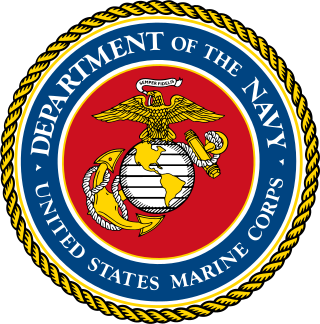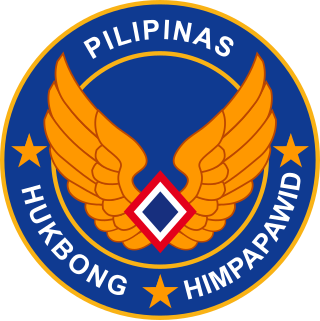Related Research Articles
The United States Armed Forces are the military forces of the United States. The armed forces consist of six service branches: the Army, Marine Corps, Navy, Air Force, Space Force, and Coast Guard. All six armed services are among the eight uniformed services of the United States.

The Air Corps is the air force of Ireland. Organisationally a military branch of the Defence Forces of Ireland, the Air Corps utilises a fleet of fixed-wing aircraft and rotorcraft to carry out a variety of duties in conjunction with the Irish Army, Irish Naval Service and Garda Síochána. The headquarters of the Air Corps is located at the Casement Aerodrome in Baldonnel, Dublin. The Air Corps has an active establishment of 886 personnel. Like other components of the Defence Forces, it has struggled to maintain strength and as of April 2023 has only 711 active personnel. Unlike the Army or the Naval Service, the Air Corps does not maintain a reserve component.

Pope Field is a U.S. military facility located 12 miles (19 km) northwest of the central business district of Fayetteville, in Cumberland County, North Carolina, United States. Formerly known as Pope Air Force Base, the facility is now operated by the U.S. Air Force via a memorandum of agreement (MOA) and an interservices support agreement (ISSA) with the U.S. Army as part of Fort Liberty.
The title flight officer was a military rank used by the United States Army Air Forces during World War II, and also an air force rank in several Commonwealth countries, where it was used for female officers and was equivalent to the rank of flight lieutenant. The term flight officer is sometimes used today to describe job title positions as aircrew members.

Air assault is the movement of ground-based military forces by vertical take-off and landing (VTOL) aircraft, such as helicopters, to seize and hold key terrain that has not been fully secured, and to directly engage enemy forces behind enemy lines. In addition to regular infantry training, air-assault units usually receive training in rappelling, fast-roping techniques, and air transportation. Their equipment is sometimes designed or field-modified to allow better transportation and/or carrying within aircraft.
The Key West Agreement is the colloquial name for the policy paper Functions of the Armed Forces and the Joint Chiefs of Staff drafted by James V. Forrestal, the first United States Secretary of Defense. Its most prominent feature was an outline for the division of air assets between the Army, Navy, and the newly created Air Force which, with modifications, continues to provide the basis for the division of these assets in the U.S. military today.

An army aviation unit is an aviation-related unit of a nation's army, sometimes described as an air corps. These units are generally separate from a nation's dedicated air force, and usually comprise helicopters and light support fixed-wing aircraft. Prior to the establishment of separate national air forces, many armies had military aviation units, which as the importance of aviation increased, were spun off into independent services. As the separation between a nation's army and air force led to a divergence of priorities, many armies sought to re-establish their own aviation branches to best serve their own organic tactical needs.
In the United States Marine Corps, a Marine Air–Ground Task Force is the principal organization for all missions across the range of military operations. MAGTFs are a balanced air–ground, combined arms task organization of Marine Corps forces under a single commander that is structured to accomplish a specific mission. The MAGTF was formalized by the publishing of Marine Corps Order 3120.3 in December 1963, "The Marine Corps in the National Defense, MCDP 1-0". It stated:
A Marine air–ground task force with separate air ground headquarters is normally formed for combat operations and training exercises in which substantial combat forces of both Marine aviation and Marine ground units are included in the task organization of participating Marine forces.
Assault Support is one of the six functions of United States Marine Corps aviation and comprises those actions required to airlift personnel, supplies or equipment into or within a battle area by helicopters or fixed-wing aircraft. It provides the Marine Air-Ground Task Force commander the ability to concentrate his strength against selected weaknesses using speed and surprise. It also provides operational and tactical mobility as well as logistics support to the Marine Air-Ground Task Force. It is used to focus combat power at the decisive place and time to achieve local combat superiority.

The United States Marine Corps is organized within the Department of the Navy, which is led by the Secretary of the Navy (SECNAV). The most senior Marine commissioned officer is the Commandant of the Marine Corps, responsible for organizing, recruiting, training, and equipping the Marine Corps so that it is ready for operation under the command of the unified combatant commanders. The Marine Corps is organized into four principal subdivisions: Headquarters Marine Corps, the Operating Forces, the Supporting Establishment, and the Marine Forces Reserve.
In the United States Army, the term combat support refers to units that provide fire support and operational assistance to combat elements. Combat support units provide specialized support functions to combat units in the following areas

The United States Army Aviation Branch is a combat arms branch within the United States Army and the administrative organization that is responsible for doctrine, manning and configuration for all army aviation units.
The United States Air Force became a separate military service on 18 September 1947 with the implementation of the National Security Act of 1947. The Act created the National Military Establishment, later renamed the United States Department of Defense, which was composed of four of the five branches, the Army, Marine Corps, Navy, and a newly created Air Force. Prior to 1947, the responsibility for military aviation was divided between the Army for land-based operations and the Navy and Marine Corps for sea-based operations from aircraft carrier and amphibious aircraft. The Army created the first antecedent of the Air Force on 1 August 1907, which through a succession of changes of organization, titles, and missions advanced toward eventual separation 40 years later. The predecessor organizations leading up to today's U.S. Air Force are:
The Howze Board was the informal name given to the Tactical Mobility Requirements Board created at the direct request of Secretary of Defense Robert McNamara to review and test new concepts integrating helicopters as close air support into the United States Army. Helicopters had been used during the Korean War to ferry wounded and supplies. Some U.S. combat officers recognized the possibility of using armed helicopters to carry heavy ordnance.

The United States Marine Corps Aviation (USMCA) is the aircraft arm of the United States Marine Corps. Aviation units within the Marine Corps are assigned to support the Marine Air-Ground Task Force, as the aviation combat element, by providing six functions: assault support, antiair warfare, close air support, electronic warfare, control of aircraft and missiles, and aerial reconnaissance. The Corps operates rotary-wing, tiltrotor, and fixed-wing aircraft mainly to provide transport and close air support to its ground forces. Other aircraft types are also used in a variety of support and special-purpose roles. All Marine Corps aviation falls under the influence of the Deputy Commandant for Aviation, whose job is to advise the Commandant of the Marine Corps in all matters relating to aviation, especially acquisition of new assets, conversions of current aircraft, maintenance, operation, and command.
Combat arms are troops within national armed forces who participate in direct tactical ground combat. In general, they are units that carry or employ weapons, such as infantry, cavalry, and artillery units. The use of multiple combat arms in mutually supporting ways is known as combined arms. In some armies, notably the British Army and Canadian Army, artillery and combat engineer units are categorized as combat support, while in others, such as the U.S. Army, they are considered part of the combat arms. Armored troops constitute a combat arm in name, although many have histories derived from cavalry units.
The Johnson-McConnell agreement of 1966 was an agreement between United States Army Chief of Staff General Harold K. Johnson and United States Air Force Chief of Staff General John P. McConnell on 6 April 1966. The U.S. Army agreed to give up its fixed-wing tactical airlift aircraft, while the U.S. Air Force relinquished its claim to most forms of rotary wing aircraft. The most immediate effect was the transfer of Army DHC-4 Caribou aircraft to the Air Force.

A squadron in an air force, or naval or army aviation service, is a unit comprising a number of military aircraft and their aircrews, usually of the same type, typically with 12 to 24 aircraft, sometimes divided into three or four flights, depending on aircraft type and air force.

The Philippine Air Force (PAF) is the aerial warfare service branch of the Armed Forces of the Philippines. Initially formed as part of the Philippine Army as the Philippine Army Air Corps (PAAC) in 1935, the PAAC eventually saw combat during World War 2 and was formally separated from the Army in 1947 as a separate service branch of the AFP under Executive Order No. 94. At present, the PAF is responsible for both defending Philippine airspace, and conducting aerial operations throughout the Philippines, such as close air support operations, combat air patrols, aerial reconnaissance missions, airlift operations, helicopter tactical operations, special operations, and aerial humanitarian operations, which includes search and rescue operations. The PAF has also carried out various missions within the country and abroad.

The Pakistan Army Corps of Aviation is a military administrative and combined arms service branch of the Pakistan Army.
References
- ↑ Pattillo, Donald M. (2001). Pushing the Envelope: The American Aircraft Industry. University of Michigan Press. p. 196. ISBN 978-0-472-08671-9.
- ↑ Leyes, Richard A.; Fleming, William A.; Fleming, William (1999). The History of North American Small Gas Turbine Aircraft Engines. National Air and Space Museum/AIAA. p. 156. ISBN 978-1-56347-332-6.
- ↑ Williams, James W. (2005). A History of Army Aviation: From Its Beginnings to the War on Terror. US Army Aviation Museum Foundation. pp. 53, 54. ISBN 978-0-595-36608-8.
- ↑ "Helicopters at War: From Vietnam To Modern Day War". Aviation History - Century of Flight. 5 December 2019. Retrieved 11 January 2022.
- ↑ Principal Investigator: Julie L. Webster, "Chapter 5 Overview of the Cold War Years" (PDF), Historical and Architectural Overview of Military Aircraft Hangars, pp. 5–5.
- ↑ The United States Air Force by Richard Irving Wolf, p. 241.
- ↑ Wolf, Richard Irving (1987), The United States Air Force: Basic Documents of Roles and Missions, Office of Air Force History, USAF, p. 151, ISBN 9781428993334
- ↑ Wolf 1987, pp. 243–245
- ↑ One consequence of the MOU was a lack of enthusiasm for Close air support alternatives such as the (two-seat) N/AW A-10B Warthog: tankkiller's page with a few pictures of the N/AW A-10B Warthog and aircraftresourcecenter's N/AW A-10B Warthog.